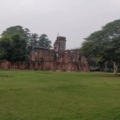An idyllic Indian village, Mangar is a picture-perfect destination brimming with exotic locals, a thriving street-art scene, and a few surprises hidden in its nooks and corners.
At first sight, Mangar comes across as a regular village, one of many that are often considered the lifeline of India. Situated a mere 20 minutes from central Gurgaon or a short half-hour drive from South Delhi on the Gurgaon-Faridabad road, it oozes the kind of rustic charm that makes villages popular among city folk.
The tiny lanes in-between houses, dung cakes nonchalantly laid out along the roads, and the sight of village elders sitting in the sun discussing the state of the nation in a calm and jovial manner.


Take a closer look, and Mangar begins to showcase its unique characteristics. Quaint features that make it a little different, a tiny bit more exciting, and definitely a lot more special than your average village.
The drive to the village is straightforward enough. A turn from the main road goes past a forest area; best travelled on during day time. The region is known for its Dhau trees, and the famous Gudariya Baba Temple.
The surrounding Mangarbani forest is considered sacred by the local community. Moreover, the “Baba” at the temple can get angry if you take photos without his permission.
The location is popular with walking groups who often arrive here on Sunday mornings to break away from the chaos of their daily lives.
Mangar also plays host to two resort destinations. The Lalit Mangar is a luxury escape that promises tranquillity and peace of mind, at a price.
Laksh Farms, the reason I visited Mangar village for the first time a few years back, is a more laid-back rural experience, although with all modern amenities you can imagine, including a swimming pool.
The location of the village in the Aravalli is quite dramatic. The oldest fold-mountain range in India is often underrated even though along its many ups and downs are some of the most captivating temples, viewpoints, adventure opportunities, and villages packed with colourful scenes of everyday life.
The final descent, leading to the first few houses of Mangar, serpents through a rocky part of the hills. It’s short, and any car can handle it but requires some careful driving.


My return to Mangar was a chance affair. A last-minute plan to visit the heart-warming animal shelter, All Creatures Great and Small, took me past the village that I still remembered from almost seven years ago. ACGS turned out to be an eye-opener.
While it is no “tourist spot” it is a lesson in compassion and care, towards animals of all sorts and a reminder that in the race to make our lives healthier, wealthier, better, we overlook other creatures who roam the world with us.
As for Mangar, while the atmosphere of the village life remained the same, it was the street art, during this visit, that eventually caught my eye.
Tip: Before starting to take photos, it’s always advisable to seek permission from the locals. When we arrived, a group of elders were playing games out in the sun. We didn’t have to say anything. We merely pointed to the camera, and they responded with a smile and a nod.

What at first looked like a few paintings of Gods and Goddesses on walls was, in reality, a slow, yet vibrant and colourful transformation of the village into something truly spectacular.
Even more surprising was the discovery that only one artist, Ravinder, does all of the art. It’s as if the village is his canvas and he has a free hand in making it stand out.


Seeing us stop and take photos of his creations, Ravi came up and introduced himself. Told us that he’s been painting the walls, with the permission of the villagers, for a while now. His source is typically old books from where he sometimes takes inspiration or else copies the art.
Ravi is a humble fellow, enthusiastic about the fact that city folk had stopped to admire this work. There’s a certain rural appeal to his art that ranges from an unfinished village scene to profiles of old political figures.
His process is to sketch out the characters first and then colour in over time. When I asked, how he managed to paint some of the art high up on the walls, he answered modestly with a “Manage kar lete hain (I manage somehow).”



I also asked Ravi about some of his art that is no longer in good condition, falling apart gradually. He informed that these were typically test pieces. Street art that he made to experiment with style or colours, and it didn’t bother him if over time they were to fade away.
A few more questions and Ravi informed us of the Village Jewel Museum and Eco Lodge. The Rs 100, – entry ticket might seem a lot for what is eventually a single room museum, but it is a beautifully presented collection.
Modern displays hold jewellery from around India and are especially worth a look if design and culture are of interest.




So, while people flock to the metros and places like Lodi Art District in Delhi to admire the ever-fascinating street-art scene, Mangar remains a little gem that quietly surprises anyone who happens to drive past its streets.






22 Comments
wanderfulweekendz
Nice pics and write up.
Ticker Eats The World
Thank you
arv!
Interesting. Is this a same place as Mangarbani? I suppose the Dhau trees are same as Dhok. If it’s a Dhok tree, it is one the most hardy resident tree of Aravalis. I have written a bit about it since I come across it frequently when I hike in Aravali hills.
Ticker Eats The World
Yes and although I was not aware, but Dhau as you rightly thought is the same as Dhok.
arv!
Great. I can’t get over its beauty during winter landscape. The rusty color dried leaves of Dhok around sunrise is a striking sight. I will definitely share a pictures of this soon. It has been sitting in my hard disk for too long!
Ticker Eats The World
Awesome. I have never seen it like that.
Carrie Ann Karstunen
What a fantastic way to brighten up the village with art that everyone can enjoy! You were so lucky to be able to meet the artist and hear about his inspiration. Mangar looks like a quaint little village, and the street art really gives it a unique look.
Anita
The street paintings look so beautiful, It reminds me of Penang in Malaysia a bit. I love to discover this kind of places with my camera. I would definately visit Lodi art disctric while in Delhi to see the stunning street arts. Thank you for sharing beautfiul photography
Amanda
I had no idea that Mangar Village even existed let alone how beautiful the art is there. How awesome that you even got to converse with the creator itself, Ravi! I would love to be able to do as he does, but I’m also curious as to how he managed to be the only one painting there. Seems lonely yet still quite beautiful.
Ticker Eats The World
I’m guessing he’s the only “artist” in the village. Also, it’s about interest, and others might not be intersted in painitng street-art.
Jane Dempster-Smith
What great artwork! Your photos were amazing. Mangar is such a beautiful place to visit. Thanks for the reminder to ask permission to take photos. Thanks for sharing.
Daniel
I actually have a friend that stays here and I visited hist home in Mangar while I was staying in Delhi. I remember how surprised I was from the beautiful street art that I found in this village that couldn’t even be found in the biggest, most urban cities of India. Your pictures look amazing too! Thank you for this post, you sure brought back some nice memories 🙂
thetennisfoodie
I have been in India but not yet in Mangar area. It looks like a very silent and quiet town. It does look very peaceful though. I need to see Laksh Farms. Great place to take photos.
Lisa
I’ve never been to India, and am always fascinated by posts like this.Mangar sounds like an interesting village, with some unique art too. You took some great photos, and I think you’re right about asking the people’s permission before taking their photo. Sometimes the end result is far natural and better!
Yukti
I never knew about mangar village but its street art is really beautiful. Though a small village, people here look happy and their love for colorful art. I loved the paintings of a woman above the door. Also, the murals of Lord Krishna and Lord Shiva are worth capturing. It is good you took permissions to take pictures and met the man behind all this colorful art.
Archana (@TravelSeeWrite)
Mangar village seems like a contrasting world – on one side there’s this rustic side of the village similar to any other village in India and on the other side it has got luxury properties like the Lalit Mangar and Laksh Farms. The street art does look quite inviting. I had not even heard about this village before.
usfman
Amazing artwork with a spiritual attraction. I would love to travel to India once more.
Ticker Eats The World
Make a trip Usfman, just do it.
shubhammansingka
Wonderful, what an unsung delight this little hamlet is !!
Ticker Eats The World
Yes, and wierdly enough quite a few people pass through it to visit the farm hourses on the other side, but not many talk about the art.